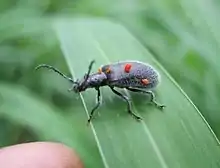Lagriinae
Lagriinae is a subfamily of long-jointed beetles in the family Tenebrionidae. There are more than 270 genera in Lagriinae, grouped into 11 tribes.[1][2][3][4]
| Lagriinae | |
|---|---|
 | |
| Statira | |
| Scientific classification | |
| Domain: | Eukaryota |
| Kingdom: | Animalia |
| Phylum: | Arthropoda |
| Class: | Insecta |
| Order: | Coleoptera |
| Infraorder: | Cucujiformia |
| Family: | Tenebrionidae |
| Subfamily: | Lagriinae Latreille, 1825 |
| Tribes | |
| |
| Diversity | |
| at least 270 genera | |
| Synonyms | |
|
Lagriidae | |
Description
Adults of Lagriinae are mostly medium-sized (5-12 mm) and have the typical Tenebrionidae features of a 5-5-4 tarsal formula and the antennal bases being hidden by canthi. The eyes are usually deeply emarginate and in many species partly surround the antennal bases. The last antennal segment is either the longest or the widest segment, and is often sexually dimorphic. The head tends to be at least as broad as the pronotum and is often constricted behind the level of the eyes. The pronotum tends to be much narrower than the base of the elytra. Additionally, the pronotum is generally broadest at its base, and its sides are sinuate or otherwise constricted.[5]
Some species resemble members of other families, like Arthromacra resembling Oedemeridae, Rhypasma resembling Silvanidae, Casnonidea apicicornis resembling Chrysomelidae, Statira resembling Carabidae and Paratenetus punctatus resembling Coccinellidae.[5]
Ecology
Lagriinae larvae feed in decaying vegetation. They can be found in stumps and under bark.[2]
Gallery
See also
References
- Bouchard, Patrice; Bousquet, Yves; Aalbu, Rolf L.; Alonso-Zarazaga, Miguel A.; et al. (2021). "Review of genus-group names in the family Tenebrionidae (Insecta, Coleoptera)". ZooKeys (1050): 1–633. doi:10.3897/zookeys.1050.64217. hdl:10261/250214. PMC 8328949. PMID 34385881.
- "Lagriinae subfamily Information". BugGuide.net. Retrieved 2021-08-06.
- Bousquet, Yves; Thomas, Donald B.; Bouchard, Patrice; Smith, Aaron D.; et al. (2018). "Catalogue of Tenebrionidae (Coleoptera) of North America". ZooKeys (728): 1–455. doi:10.3897/zookeys.728.20602. PMC 5799738. PMID 29416389.
- Bouchard, Patrice; Bousquet, Yves; Davies, Anthony E.; Alonso-Zarazaga, Miguel A.; et al. (2011). "Family-group names in Coleoptera (Insecta)". ZooKeys (88): 1–972. doi:10.3897/zookeys.88.807. PMC 3088472. PMID 21594053.
- "Lagriinae". uk beetles. Retrieved 2023-07-02.
Further reading
- LeConte, J. L. (1861). Classification of the Coleoptera of North America. Smithsonian Miscellaneous Collections. Vol. 3. Smithsonian Institution. doi:10.5962/bhl.title.38459. ISBN 978-0665100550.
- Somerby, Ronald E.; Thomas, Donald B.; Triplehorn, Charles A. (2002). "Family 106: Tenebrionidae". In Arnett, Ross H. Jr.; Thomas, Michael C.; Skelley, Paul E.; Frank, J. Howard (eds.). American Beetles, Volume II: Polyphaga: Scarabaeoidea through Curculionoidea. CRC Press. pp. 463–509. ISBN 978-0-8493-0954-0.

